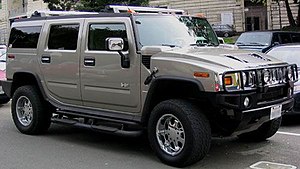| Revision as of 23:58, 29 December 2004 view source200.144.29.45 (talk) →History← Previous edit | Revision as of 23:59, 29 December 2004 view source 200.144.29.45 (talk) →SafetyNext edit → | ||
| Line 15: | Line 15: | ||
| ==Safety== | ==Safety== | ||
| Cu! | |||
| ] seem as old as automobile vehicles themselves. ] crashed his steam-powered "Fardier" against a wall in ]. The first recorded automobile fatality was ] on ], ] in ] and the first in the ] was ] on ], ] in ]. | |||
| Every year more than a million people are killed and about 50 million people are wounded in traffic (according to ] estimates), either by crashing into something, or by being crashed into. Major factors in accidents include driving under the influence of ] or other drugs, inattentive driving, overtired driving, road hazards such as snow, potholes and animals, and reckless driving. Special safety features have been built into cars for years, some for the safety of car's occupants only, some for the safety of others. | |||
| Cars have two basic safety problems: They have human drivers who make mistakes, and the wheels lose traction near a half gravity of deceleration. Automated control has been seriously proposed, and successfully prototyped. Shoulder-belted passengers could tolerate a 32G emergency stop (reducing the safe intervehicle gap 64-fold) if high-speed roads incorporated a steel rail for emergency braking. Both "safety" modifications of the roadway are thought to be too expensive by most funding authorities, although these modifications would dramatically increase the number of vehicles that could safely use a high-speed highway. | |||
| Early safety research focused on increasing the reliability of brakes, and reducing the flammability of fuel systems. For example, modern engine compartments are open at the bottom so that fuel vapors, which are heavier than air, drain to the open air. Brakes are hydraulic so that failures are slow leaks, rather than an abrupt cable-parting. Systematic research on crash safety started in ] at ]. Since then, most research has focused on absorbing external crash energy with crushable panels, and reducing the motion of human bodies in the passenger compartment. | |||
| There are standard tests for safety in new automobiles, like the ] and the US NCAP tests (http://www.nhtsa.dot.gov/cars/testing/ncap/). There are also tests run by organizations backed by the insurance industry (IIHS for instance at http://www.hwysafety.org/). | |||
| Despite technological advances, the death toll of car accidents remains high: about 40,000 people die every year in the US, a number which increases annually in line with rising population and increased travel (although the rate per capita and per mile travelled decreases steadily), with similar trends in ]. The death toll is expected to nearly double worldwide by ]. A much higher number of accidents result in injury or permanent ]. | |||
| ===See also=== | ===See also=== | ||
Revision as of 23:59, 29 December 2004
- Car redirects here. For alternate meanings of car, see Car (disambiguation).
An automobile, usually called a car (an old word for carriage) or a truck, is a wheeled vehicle that carries its own engine. Older terms include horseless carriage and motor car, with "motor" referring to what is now usually called the engine. The act of operating an automobile is called driving. An automobile has seats for the driver and, almost without exception, for at least one passenger.
General
Automobiles are designed to travel on roads, although some, notably sport utility vehicles (also called off-road vehicles), allow off-road driving. Roads and highways are shared with other traffic such as motorcycles, tractor trailers, farm implements, and bicycles.
The typical vehicle has an internal combustion engine, although in 2001, hybrid cars powered by gas-electric hybrid engines began to enter the market. Other vehicles run on electricity and fuel cells, though these are not widely available as of 2004. While most cars have four wheels, three-wheeled automobiles have also been built, but are not common due to stability problems. Some gyrocar, two wheeled automobiles have been built as well, using gyroscopic stabilization.
There are many classes of car and car body styles.
Where I write?
Safety
Cu!
See also
Major possible subsystems
- Ancillary power - mechanical, electrical, hydraulic, vacuum, air
- drivetrain
- body
- crumple zones
- monocoque (or unibody) construction
- suicide doors
- interior equipment
- passive safety
- controls
- seats
- ancillary equipment such as stereos, air conditioning, cruise control, car phones, positioning systems, cup holders, etc.
- exterior equipment
- windows
Related topics
Lists and categories
- Automobiles category
- Automotive technologies category
- List of automobile manufacturers
- List of famous automobiles
Articles
- ambulance
- armored car
- auto show
- carfree movement
- crash
- diesel cycle; four-stroke cycle; two-stroke cycle; Miller cycle; Atkinson Cycle
- effects of the automobile on society
- forklift
- future of the car
- flying car
- greenhouse gas
- Hybrid car
- High Occupancy Vehicle (HOV)
- license plate
- parking
- parking meter
- parking ramp
- Personal Rapid Transit (Proposed as an alternative to cars)
- power transfer
- public road
- Reclaim the Streets
- Station wagon
- road
- road safety
- tank
- traffic law
- truck
- urban car
- Woodie
- Stirling engine
External links
- Template:Wia
- EuroNCAP
- U.S. Department of Transport Fatal Accident Statistics
- National Transportation Safety Board
- Gas milleage impact calculator.
Images of automobiles, past and present
Images can also be found on the Wikimedia Commons "car" page and on the Misplaced Pages automobile gallery
|
|
 |
 |
|
 |
 |
|
|
 |
 |
|
|
|
 |
 |
|
 |
 |
 | |
|
| |